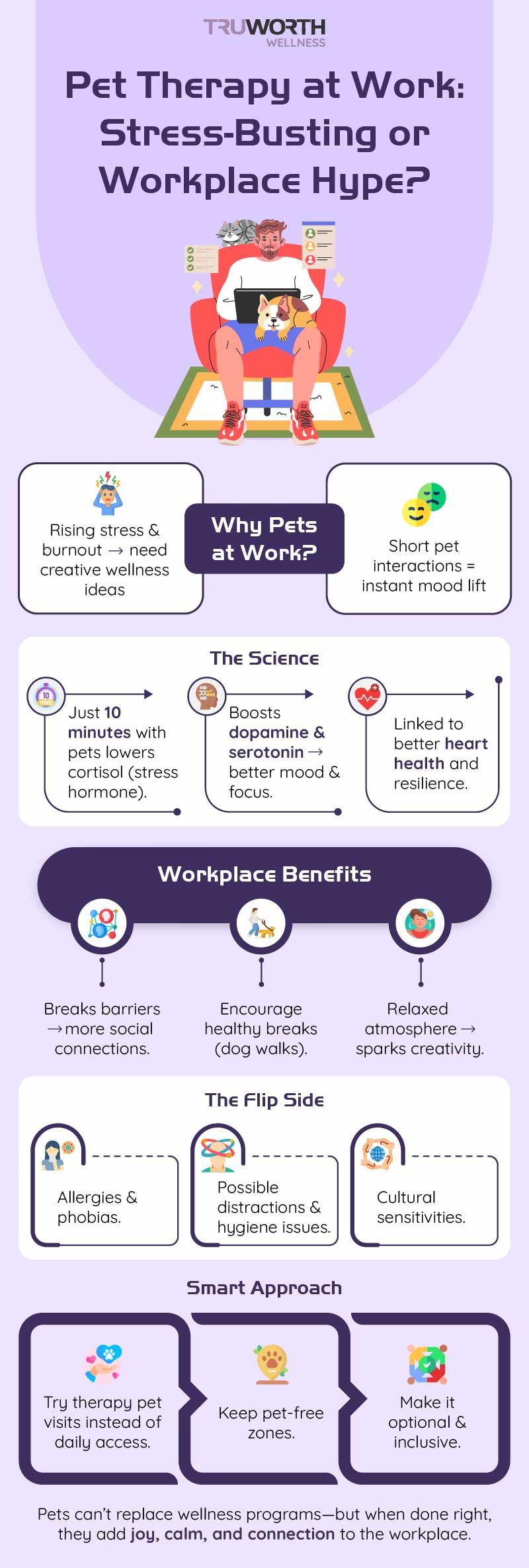Pet-Friendly Offices: The Next Big Trend In Employee Wellness

Picture a friendly dog wagging its tail as it strolls into the office, or a calm cat curling up near your desk. Within moments, stress levels dip, conversations spark, and the atmosphere feels lighter. This is the power of pet therapy at work, an unconventional yet increasingly popular approach to workplace wellness.
As stress, burnout, and disengagement grow in modern workplaces, organizations are experimenting with unique strategies that go beyond the traditional health check-ups or gym memberships. Among these, pet therapy has become a surprising contender. But should pets really be allowed in offices? And is this wellness practice practical—or just a passing trend?

Why Pets in the Workplace Are Gaining Popularity?
Wellness is no longer about just physical health; mental and emotional well-being are now central to employee engagement. Interacting with animals has proven effects such as:
- Reducing cortisol levels (the primary stress hormone).
- Lowering blood pressure and heart rate during stressful situations.
- Boosting serotonin and dopamine, chemicals linked with happiness and calmness.
- Encouraging social interaction among employees, breaking workplace silos.
Large companies like Amazon and Google are already pet-friendly, while smaller firms are organizing scheduled pet therapy sessions where trained animals visit the office. For many, this isn’t just a perk—it’s a workplace culture enhancer.
The Science Behind Pet Therapy
Scientific research strongly supports the health benefits of interacting with pets:
- The American Heart Association links having pets with reduced cardiovascular risk.
- Psychology research shows pets provide a sense of unconditional support, which improves resilience and mental clarity.
In workplaces, these findings translate into measurable outcomes like:
- Fewer stress-related absences.
- Improved focus and creativity.
- Enhanced team bonding and morale.
How Pets Impact Workplace Culture?
Introducing pets into workspaces doesn’t just reduce stress—it also reshapes how people interact. Some key cultural benefits include:
- Breaking Barriers – Pets are conversation starters. Colleagues who rarely interact often bond over a dog’s antics or a cat’s charm.
- Encouraging Breaks – Walking a dog provides employees with healthy, active breaks from their desks.
- Boosting Creativity – A relaxed atmosphere sparks new ideas and better problem-solving.
- Humanizing Workplaces – Pets add warmth, making offices feel less transactional and more community-driven.
When employees feel emotionally comfortable at work, their productivity naturally rises.
The Flip Side: Why Pet Therapy May Not Be for Everyone?
While the benefits are compelling, pet therapy is not universally suitable:
- Allergies and Phobias – Some employees may suffer allergic reactions or have genuine fears of animals.
- Distractions – A playful dog could disrupt focus if not well-trained or managed.
- Cultural Sensitivities – In diverse workplaces, not all employees are comfortable with animals in professional spaces.
- Hygiene Concerns – Offices must ensure cleanliness, particularly in shared spaces.
This makes inclusivity essential. Instead of daily pet access, many organizations choose scheduled therapy visits so employees can decide whether to participate.
Also Read: If You Feel Like “Therapy Just Isn’t For Me,” Read This
Should Pets Really Be Allowed in Offices?
This is the critical question. While pet therapy’s advantages are clear, simply declaring an office “pet-friendly” isn’t always practical. Leaders need to weigh emotional benefits against logistical challenges.
For some organizations, the positives—reduced stress, higher engagement, and a friendlier culture—make it worthwhile. For others, especially in high-pressure or tightly regulated environments, pets may create more challenges than solutions.
A balanced approach works best:
- Pet-friendly days instead of every day.
- Certified therapy animal visits rather than employees’ personal pets.
- Opt-in programs that respect individual preferences.
Ultimately, the goal isn’t to make every workplace pet-friendly, but to explore how pet therapy can be introduced thoughtfully—boosting wellness without compromising productivity or inclusivity.
Best Practices for Introducing Pet Therapy at Work
If your company is considering pet therapy, here’s how to implement it responsibly:
- Start Small – Pilot the program with occasional visits before making it permanent.
- Create Pet-Free Zones – Provide designated areas for employees who prefer not to interact with animals.
- Set Clear Guidelines – Establish rules for hygiene, pet behavior, and employee conduct.
- Gather Employee Feedback – Regularly measure comfort levels and wellness impact.
- Work with Professionals – Certified therapy animals are trained to remain calm, friendly, and predictable.
This structured approach ensures that pet therapy contributes positively without creating new stressors.
The Bigger Picture: Pets as Part of Holistic Wellness
It’s important to remember that pets aren’t a silver bullet for workplace stress. Pet therapy should complement, not replace, broader wellness initiatives such as:
- Stress management workshops
- Mental health support programs
- Physical fitness opportunities
- Employee assistance helplines
When integrated into a holistic wellness strategy, pets become a joyful catalyst—adding warmth, reducing tension, and fostering a sense of belonging.
Conclusion
The sight of a dog wagging its tail down the hallway or a cat purring softly in a meeting room may feel unusual, but the science is clear: pet therapy at work can lower stress, spark connection, and improve workplace well-being.
However, it’s not for everyone. Allergies, fears, and cultural differences mean organizations must proceed thoughtfully. Rather than asking, “Should pets always be allowed at work?” the real question is, “How can we design pet therapy programs that are inclusive, optional, and effective?”
When done right, pets in the workplace offer more than just smiles—they provide employees with moments of calm and joy that ripple into better performance, healthier teams, and stronger workplace cultures.